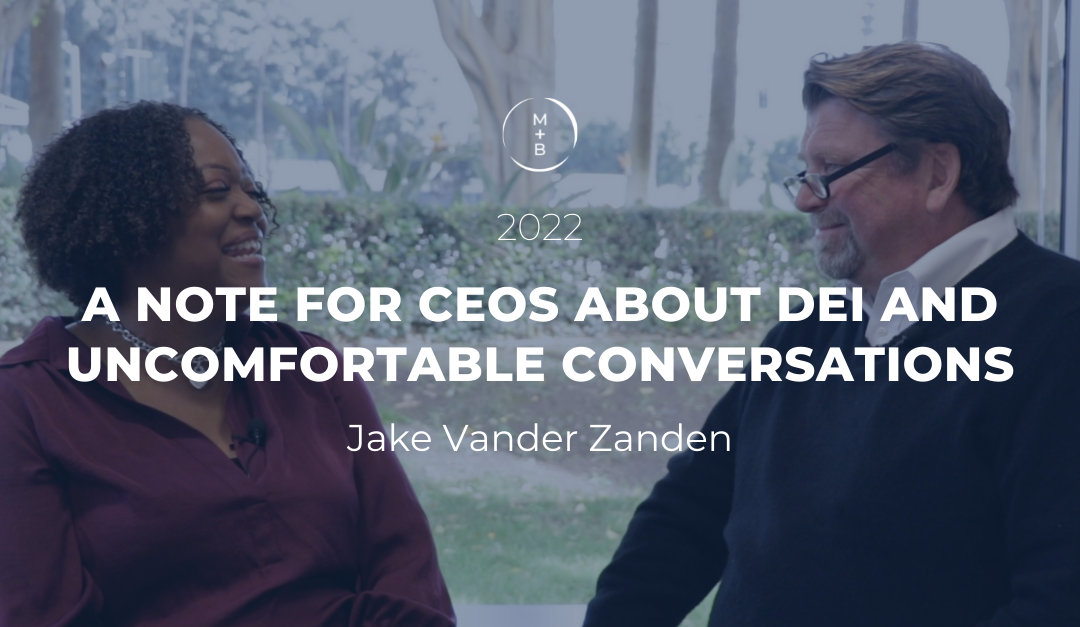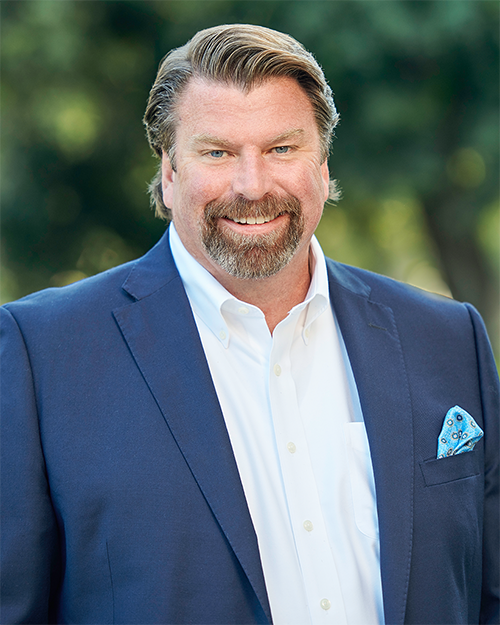I work with a lot of CEOs and executive leaders on a daily basis. One of the things that I, and many other senior executives, struggle with is confidently being a part of the conversation around Diversity, Equity, and Inclusion (DEI). Sometimes, I fear I may say or do something that is offensive unintentionally, and I know I am not alone in this feeling. So, I recently sat down with my close friend and colleague, Stacey Lewis, former CHRO of the Port of Long Beach and CEO of HR Interrupted. Stacey is an expert on Diversity, Equity, Inclusion, and Belonging and she gave me some great advice for navigating these feelings of fear and answering some of my questions around DEI.
Creating a Safe Space and a Sound Ecosystem
There is no doubt that the CEO holds the most accountability and has the most visibility internally and externally as the ultimate decision-maker. But, by not contributing to or engaging in the conversation around DEI — their voice of leadership, direction, and vision is lost. When I spoke with Stacey about this, she said she often hears CEOs say:
I don’t understand this [DEI]. I can’t give my best if I don’t agree with something, simply because I don’t understand it… and it has not been a part of my experience until this point. I know it’s the right thing to do – but I struggle for fear of saying or doing the wrong thing and being canceled, terminated, or losing everything.
At this level, the CEO’s purpose is to drive awareness and must have this voice and representation. Stacey and I discussed that the best way to do this is to have the right people in place and a strong support system. Within the CEO’s inner circle, they should have a safe space with someone they can confide in and be vulnerable with to voice their true feelings of confusion, fear, and apprehension. Having the right people in place, aligning within this ecosystem, will help get the work done to drive an effective, authentic, and impactful DEI strategy from the top down.
The Differences in Equity and Equality
Another term that I wanted to more carefully explore and understand was “equity,” and how this is different from “equality.” I asked Stacey this question and she gave me an excellent example of how they differ and what this means.

Jake, think about equity and equality like this. Let’s say, for example, I am 5’4 and you are 5’10. When we stand on flat ground together, we have different access to the things we can see, reach, and do. Now, if we are both given a box that is 6” tall to stand on — we may be equal if we were given the same resource [the box to stand on] — but you are still taller than I am. Now, if I am given an 8” box to stand on, and you are given a 2” box to stand on — that’s equity. Even though my box is taller, we now have the same access to opportunities and can reach and do similar things. Everyone does not start on equal footing so providing the resources for those who need it — that creates equity. When you have equity you create belonging, and that is the real foundation of DEI.
The point that hit home for me was to provide everyone equitable access. To create equity, we need to give people the resources they need with consideration of where they are at. In executive search and talent acquisition, equity begins with sourcing, including:
Opportunities
Promote opportunities beyond your immediate network. Cast your net wide for broader exposure to proactively create equitable access to an opportunity.
Language
Use gender-neutral language and words in descriptions and position profiles.
Pronouns
Be inclusive and mindful of pronoun usage and references.
Experiences
Honor the way that people have lived their experiences and how this impacts their approach to work.
Let’s take it one step further into the talent management side of HR and talk about the employee experience. When an employee is onboarded, their manager must assure that access to your company’s offerings, benefits, career map, etc. are available and equitable. To drive commitments to DEI forward, let the new employee know that they matter and are valued by giving them a career map. Recently, a large silicon valley tech giant was accused of suppressing certain diversity groups from advancing within the organization by placing them in jobs or career tracks that made it difficult or nearly impossible. In this case, equity was never at the forefront of the recruitment or talent management process and the fragmented approach to DEI resulted in failure.

The “What” and the “Why” Behind DEI Mandates
From my conversation with Stacey, we both agreed that people don’t like mandates and don’t like to be told what to do — including something as simple as wearing a mask. But, we know mandates are put in place to help people and give them a framework for navigating the unknown. When it comes to DEI, if left to their own devices, companies would probably never achieve or implement DEI practices.
With social and political commentary from the killing of George Floyd and with BLM putting pressure on companies to do better at DEI, organizations are sent into a reactive and frenzied state to hastily act. I can tell you as a search consultant, this is not a strategy to follow. When a company makes a large donation to a nonprofit, a public statement, or an arbitrary diversity hire, people see right through this as performative and it falls flat.
Stacy gave me some great advice:
CEOs and companies must first step back to look at the “what” and the “why” of DEI. Ask yourself, ‘What are you really doing with DEI? What do you really believe? What are your priorities? Why are you doing it?’ If you build a foundation off of the “what” and the “why” of DEI, then the rest, “the how,” will follow.
When it Comes Down to “Cultural Fit”
When I partner with a company that is looking for diverse candidates as their leading search criteria, I have them first consider why. I will ask them, “Why are you hiring for this position? Is there an actual need for it?” If there isn’t, then this person will not succeed in the role. Second, is the infrastructure in place to support DEI experiences and careers that create real equity and inclusion? If the answer to these questions is yes, then I search for the best-qualified candidates that are in alignment with the company’s mission, vision, and values.
What comes next, I have seen happen several times. The company will arrive at two finalist candidates. One has intersectional diverse qualities (for example, a person of color and part of the LGBTQIA+ community), while the other candidate is fairly homogeneous compared to the wider team — but they are both equally qualified. In the end, the company will choose to hire the non-diverse candidate for the simple reason that “it was a better fit.” When I voiced these frustrations with Stacey she said:

Were these two candidates any different in qualification, or did either one of them demonstrate in the process that their skills, values, vision, and mission were not aligned with the organization? Chances are likely not — so the “not a good fit” excuse isn’t a valid reason. There are all sorts of unconscious biases we can dive into, but the real question we need to ask to reframe this mindset is this: when the company began this process, were they more interested in someone fitting into their culture or pursuing diversity as a culture add? If a company says they have room for growth, which we all do, we should pivot this thinking of cultural fit to be more proactive.
Zero-Tolerance and Cancel Culture
I feel like in the world today, there is a zero-tolerance mindset and there isn’t really a way to navigate around it. I wanted to know from Stacey, at what point do we move away from zero-tolerance and cancel culture to education and awareness?

You have to have empathy. Regardless of where you sit on the side of an issue, everyone must have empathy. Activate your intellectual curiosity to recognize there is another point of consideration, and understand that this has always been someone’s reality and experience, affirmed at a very young age through validation of very powerful influences. It’s incredibly difficult to erase what has been programmed into us, but where the road diverges and where zero-tolerance should play a role is in the behavior. The behavior we can manage and change.
One of the things that I learned overseas is that the American way is not the only way to do something. This lesson still stays with me today, and what it means to me is that all ideas and people come from different points of view and experiences. The other day I was speaking with my two daughters about pronouns and the use of “they,” admitting in the past that I have slipped up and misused pronouns. My own daughters explained to me exactly what Stacey had mentioned about empathy and honoring both my and this individual’s lived experiences. This helped reframe my struggle with understanding, but I realized the real work on my part — what I could truly change — was my behavior. I can try as hard as possible to honor, say, and use an individual’s correct pronouns, but if I fumble and mess up, I’ll correct myself until my behavior and my language change. Language is power and language is everything when it comes to DEI.
Continue the Conversation
There were so many other things that Stacey and I spoke about in our conversation, and I was very grateful that she created this safe space for me to openly have these vulnerable and taboo conversations. Afterward, I found my awareness, approach, and confidence had shifted from a place of fear and apprehension to curiosity and action; and I felt more equipped to have a voice in this space and move the conversation forward.
This conversation with Stacey is the beginning of a new series we are launching called “Let’s Chat.” To watch clips from my conversation with Stacey click here.
Jake Vander Zanden
Partner
(949) 541-5000
jake@mbexec.com
Jake Vander Zanden serves as a Partner and leader of McDermott + Bull’s Technology Life Sciences Practice.
Jake spent over 25 years as a turnaround and growth leader completing business transformations as a senior executive at companies like Allergan, Medtronic, and more. He has lived and worked throughout Asia, Africa, and Europe, and managed businesses in all the major regions of the world. Jake’s success has come from his ability to quickly and continuously develop high performing teams and guide their achievement of company changing initiatives, regardless of country, language, culture, or product group.


